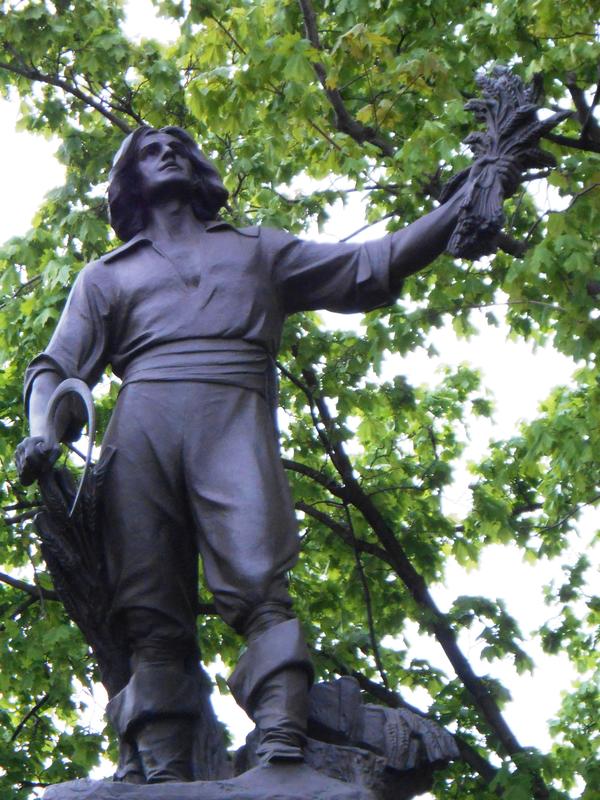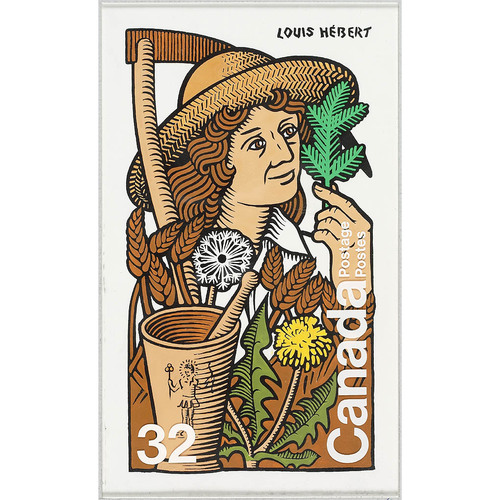
Source: Courtesy of Wikimedia Commons
HÉBERT, LOUIS, apothecary, colonist, and king’s attorney; b. 1575 in Paris, son of Nicolas Hébert and Jacqueline Pajot, widow of a previous marriage and later widow of Louis de Cueilly; m. 19 Feb. 1601 Marie Rollet (who signed Rolet), widow of François Dufeu, in the parish of Saint-Sulpice in Paris, and they had three children; d. 25 Jan. 1627 at Quebec.
Life in France
Louis Hébert’s arrival in New France and his life there cannot be understood without placing it in the broad context of his life in France. Until the age of 30 Hébert lived in Paris, close to the Louvre, which was at that time the palace of the kings of France. He was born in the large residence of the Mortier d’Or. His father Nicolas was an apothecary and also managed about ten houses in the area. This impression of opulence was a little misleading: Louis’s mother, Jacqueline Pajot, had previously been married twice, and these residences were for the most part intended for the children from her second husband’s first marriage. Besides, in 1596, following the siege of Paris (1589–90) by King Henri III and his successor, Henri de Navarre, Nicolas was imprisoned for two years on charges of debt. Louis’s family fortune would amount to very little.
Hébert was born of the third marriage of Jacqueline Pajot, who died in 1579 or 1580. Her elder sister Charlotte subsequently looked after the child and saw to his upbringing until she married some three years later. From then on his new stepmother, Marie Auvry, took her place. Hébert had another sister, Marie, and a brother, Jacques, who entered the humble and austere religious order of the Minims. His father was also responsible for the heirs of his wife’s second marriage. In about 1591–92 one of them, Jacques de Cueilly, curé of Saint-Germain-l’Auxerrois, protested so vehemently against Henri IV that his extremist behaviour provoked opposition from the Roman Catholic party known as the Politiques.
From 1588 to 1590 Hébert’s adolescence was much disrupted by the final episodes of the Wars of Religion, and particularly by the siege of Paris, which, according to Pierre de L’Estoile, a reliable contemporary observer, was responsible for the deaths of 30,000 people (13,000 of them from starvation) in that city of some 220,000 inhabitants. Therefore, from age 13 to 15 Hébert lived amid famine, confrontation, and physical and religious violence.
Descended from a long line of apothecaries, Hébert continued the family tradition. He received a basic education for five years and then attended classes in grammar and the humanities, during which he learned Latin. He subsequently completed another five years of intensive study under the guidance of masters. He discovered the uses of plants, the various properties of leaves, fruits, and roots, as well as different ways of preparing therapeutic dosages from them. At the time, remedies developed from plants were the mainstay of the medicinal system. In 1600, at the conclusion of his studies, Hébert presented himself as a Parisian bourgeois, grocer, and apothecary merchant.
On 19 February the following year, Hébert married Marie Rollet, a strong-willed, resourceful young woman from a good family. They soon became parents and sought to settle down and run a shop. Their situation, however, was not an easy one. In July 1602 Hébert bought a small tumbledown dwelling on the banks of the Seine and undertook repairs. To do so, he signed four different contracts before four different notaries and provided four different residential addresses. All indications are that the efforts to launch a professional practice of good standing did not meet expectations.
Journeys to Port-Royal
In March 1606 Hébert reached an agreement with the explorer Pierre Dugua de Monts to serve a year in New France. His appointment as an apothecary brought him 100 livres, of which 50 were in cash. The total remuneration was 50 livres less than that of an edge-tool maker, but Hébert received 20 livres in cash more than most of the other people recruited. The choice of New France may be explained by the fact that in 1590 one of his cousins, Claude Pajot, had entered into a marriage contract with Jean de Biencourt de Poutrincourt et de Saint-Just, a distinguished nobleman who wished to command the colony of Port-Royal (Annapolis Royal, N.S.) and who was a member of the Dugua expedition.
Various episodes stood out in Hébert’s two sojourns in Port-Royal between 1606 and 1613. He admired the landscapes and nature’s rich abundance. He tested the fertility of the soil, as reported by the traveller and writer Marc Lescarbot in his Histoire de la Nouvelle-France: “Poutrincourt … had a piece of land cultivated there to sow wheat and plant vines, as he did with the help of our apothecary, M. Louis Hebert, [a] man who, besides being experienced in his art, took great pleasure in tilling the soil.” On 5 Sept. 1606, at Dugua’s instigation, Poutrincourt set off south in search of a new place to settle. The expedition, in which Hébert and the explorer Samuel de Champlain participated, stopped in various locations and attempts were made to plant wheat and vines. On 2 October, after arriving at Port Fortuné (Stage Harbour, Mass.), Hébert uprooted good, strong vines to transport to Port-Royal. One night some 400 Armouchiquois, the name given to the Abenaki by the French, attacked five men who had stayed on land. Alerted by shouts, Hébert and the Frenchmen who had remained aboard the boat grabbed their rifles and managed to fend off their assailants. Of the five men, only one survived. Hébert is reported to have cured Robert Gravé Du Pont, who had been wounded in the hands when his rifle exploded, with terra sigillata. The members of the expedition returned to Port-Royal on 14 November. Because Dugua’s monopoly of the fur trade had been revoked in 1607, Hébert went back to France. It was renewed the following year, perhaps because Poutrincourt made a case to Henri IV about the agricultural possibilities of the territory, presenting him with around ten different plants.
Hébert returned to Port-Royal in 1611. Now a mature man over 35, he acted as mediator the following March between Charles de Biencourt de Saint-Just, who at just 20 years of age was governing New France, and the Jesuits, who were demanding more assistance and had decided to deprive the young colony of religious services [see Pierre Biard]. On 24 June, after three months of conflict, the Jesuits opted to settle farther south. They left Port-Royal after a meeting with Hébert that proceeded in a friendly manner. In May 1613 Hébert took charge of Port-Royal in Biencourt’s absence. Although his interest in the new lands was undiminished, he returned to France the same year, just as British colonial troops seized control of Port-Royal [see Sir Samuel Argall].
Settling in New France
In 1617 Hébert became reacquainted with Champlain and, it would seem, expressed his desire to settle at Quebec, especially since the Compagnie des Marchands de Rouen et de Saint-Malo would offer him an attractive employment contract if he did. He divested himself of his belongings and reached the port of Honfleur with his wife, children (Anne, Guillemette, and Guillaume), and brother-in-law (Claude Rolet (Rollet)). According to the Recollet Joseph Le Caron the company significantly scaled back the conditions of the agreement, however. Instead of the 200 livres per year promised for three years, Hébert would receive an annual salary of 300 livres for only two years, after which he would have to live off his labour. Furthermore, the produce from working the land was to be turned over to the company and Hébert would have to treat people free of charge. He protested, but in vain. On 6 March 1617, a few days before his departure – homeless, with no material possessions, and in a very vulnerable position – he signed the contract that took him to New France.
Hébert arrived in Tadoussac on 14 June and travelled to Quebec at the beginning of July. Over the next few months he built a wooden house. With the help of employees of the Compagnie des Marchands de Rouen et de Saint-Malo, he subsequently saw to the construction of a stone house, which he would occupy from 1620. These dwellings stood where the inner courtyard and parking lot (near the Rue des Remparts), respectively, of the Petit Séminaire de Québec are located in the early 21st century. Hébert cleared the land and sowed a plot with good grain, vegetables, and various herbs. He also planted grapevines and apple and plum trees. Champlain, in his Œuvres, describes Hébert as the first head of a family to subsist on what he grew. In 1623 the Duc de Montmorency, viceroy of New France, recognized Hébert’s ownership of his lands on the promontory. In the early 21st century these locations correspond to the sites of the Petit Séminaire de Québec and part of the property of the Hôtel-Dieu. Three years later the Viceroy of Ventadour made the tracts into a noble fief, which would be known as Sault-au-Matelot; he also granted Hébert a piece of land on the Saint-Charles River, later named the fief of Saint-Joseph (Lespinay). Hébert subsequently received powers and privileges more or less equal to that of a seigneur: land grants, a reserved church pew, and the right to collect rents and a poll tax.
Although documentary evidence from the period is imperfect, it seems clear that Hébert served as an example, and his situation a pretext, in the struggle against the rigid commercial objectives of the Protestant company of the de Caën family [see Émery de Caën; Guillaume de Caën] and, to a lesser extent, those of the former Compagnie des Marchands de Rouen et de Saint-Malo. At the end of 1621 or early the following year the Recollet Father Georges Le Baillif published, in the name of the people’s assembly, an incendiary tract titled Plainte de la Nouvelle-France, dite Canada, à la France sa germaine ; pour servir de factum en une cause pendante au conseil, which was based in part on false documents. Hébert, in his capacity as king’s attorney, signed a petition addressed to King Louis XIII. In 1626 Le Caron produced a memorandum denouncing in turn the behaviour of the companies. A third of the dispatch was devoted to Hébert and his efforts at colonization, his requests for relaxing the terms of his contract, and the difficulties he purportedly faced at the hands of the de Caën family, who had granted themselves the exclusive right to lend him money (at the rate of 25 per cent), refused to provide him with a plough and two hired men, and dismissed complaints about damage caused by their pigs. The de Caën family, in order to calm the rumblings of dissent in the colony, to keep Hébert and his clan quiet, and to show that the latter were dependent on them, paid the Hébert household 100 livres annually in provisions.
Relations with Indigenous people
Hébert maintained firm friendships with the Indigenous people, who passed on to him extremely important knowledge of the natural world. Examples of these connections come from one of his sojourns in Port-Royal. In late June 1611 Actodin, the son of the great Souriquois (Micmac) chief Membertou, was dying. According to custom he isolated himself so as not to unsettle his community. Informed of the situation, Hébert went to see him and cured him. The Jesuits claimed it was a miracle. Two months later Membertou was at death’s door. Hébert, who regretted not being able to save him, cared for him in the final moments of his life. The main evidence of Hébert’s close relationship with the Indigenous people remains the baptism on 23 May 1627 of Naneogauchit, son of the Montagnais chief Chomina, during which Marie Rollet, by then a widow, acted as godmother. She subsequently hosted a feast on her land. In her great brewing cauldron, the guests placed 56 wild geese, 30 ducks, 20 teal, a quantity of game, 2 barrels of peas, one barrel of biscuits, 20 pounds of prunes, 6 baskets of corn, and a few other foodstuffs. After the people were sated, the festivities were brought to a close with a traditional Indigenous dance.
Role in the birth of botany in Europe
During his stay in the colony Hébert raised his apothecary work to a very high standard and facilitated the role of New France in the emergence of botany in Europe. All of Hébert’s accounts indicate that he had sent plants to France. Among them were the American groundnut, which was harvested for food; meadow-rue, which he used to promote sweating and the healing of wounds; and Canadian wild ginger, whose ginger-flavoured rhizomes would, he believed, help rid the body of noxious fluids. Hébert undoubtedly owned illustrated identification guides.
Jean Robin, a botanist and apothecary born 25 years before Hébert, gave lectures on plants at the Faculté de Médecine in Paris, where he also tended the garden. Hébert had no doubt been his pupil at about the same time as Robin’s son Vespasien, for it was to that garden specifically that Hébert sent the plants he chose, varieties that were unknown in Europe. Vespasien would later transplant some of them in the Jardin Royal des Herbes Médicinales when it was created in 1635. That same year in Paris the botanist Jacques-Philippe Cornuty published Canadensium plantarum …, the first book on plants in Canada. This work describes and illustrates 45 plants that were previously unknown in Europe, and it often refers to the specimens found in the Robins’ garden. It seems that Hébert had a further indirect connection with Cornuty: living among the Minims, his brother Jacques rubbed shoulders with one of the greatest scientists of the day, Marin Mersenne, whom Cornuty himself had treated. Hébert probably also owed some of his botanical knowledge to the Souriquois as they used several of the same species of plants. According to historian Adrien Huguet, they nicknamed him “the plant gatherer.”
Assessment
Early in the winter of 1627 Louis Hébert had a fall on the ice, which proved fatal. He died on 25 January and was buried in the Recollet cemetery. In 1678 his remains were transferred to the vault of the Recollet chapel and laid to rest next to those of Brother Pacifique Duplessis. In the Premier établissement de la foy dans la Nouvelle-France …, the Recollet priest Chrestien Le Clercq named Hébert, who had numerous descendants in New France, the “Abraham of the colony.” A model for future settlers and a professional practitioner who was resilient and accommodating, Hébert, supported by Marie Rollet, was the embodiment of a man who focused on building a new world.
Arch. Nationales (Paris, Fontainebleau et Pierrefitte-sur-Seine), LL//958, 19 févr. 1601. Alain Asselin et al., Curieuses histoires de plantes du Canada (3v. parus, Québec, 2014– ), 1. Champlain: la naissance de l’Amérique française, sous la dir. de Raymonde Litalien et Denis Vaugeois (Sillery [Québec] et Paris, 2004). [Samuel de Champlain], Œuvres de Champlain, C.‑H. Laverdière, édit. (2e éd., 5 tomes en 6v., Québec, 1870). François Droüin, “Une chute fatale: mort et sépultures à Québec au début du XVIIe siècle,” Cap-aux-Diamants (Québec), no.128 (hiver 2017): 17–20. Benoît Grenier, “Louis Hébert: premier seigneur canadien,” Cap-aux-Diamants, no.128: 13–16. Adrien Huguet, Jean de Poutrincourt, fondateur de Port-Royal en Acadie, vice-roi du Canada, 1557–1615 … (Paris, 1932). M[adeleine] Jurgens, “Recherches sur Louis Hébert et sa famille,” Soc. Généal. Canadienne-Française, Mémoires (Montréal), 8 (1957): 107–12; “Recherches sur Louis Hébert et sa famille, II: Nicolas Hébert,” Soc. Généal. Canadienne-Française, Mémoires, 8: 135–45; “Recherches sur Louis Hébert et sa famille, III: Louis Hébert,” Soc. Généal. Canadienne-Française, Mémoires, 11 (1960): 24–31. Jacques Lacoursière, “Louis Hébert, ‘l’Abraham de la colonie,’” Cap-aux-Diamants, no.29 (printemps 1992): 58–61. [Joseph Le Caron], Au roy sur la Nouvelle-France (s.l., 1626). Marc Lescarbot, Histoire de la Nouvelle-France: suivie des Muses de la Nouvelle-France (nouv. éd., 3v., Paris, 1866), 2. [Pierre de L’Estoile], Journal de L’Estoile pour le règne de Henri IV (3v., Paris, 1948–60). Jacques Mathieu, Le premier livre de plantes du Canada: les enfants des bois du Canada au jardin du roi à Paris en 1635 (Sainte-Foy [Québec], 1998). Jacques Mathieu et Alain Asselin, “Louis Hébert, apothicaire, et la contribution du Nouveau Monde à l’Ancien Monde,” Cap-aux-Diamants, no.128: 4–7; La vie méconnue de Louis Hébert et Marie Rollet (Québec, 2017). Monumenta Novæ Franciæ, Lucien Campeau, édit. (9v., Rome et Québec, 1967–87; Rome et Montréal, 1989–2003), 2 (Établissement à Québec (1616–1634)). Public Arch. of Can., Nouveaux documents sur Champlain et son époque, Robert Le Blant et René Baudry, édit. (Ottawa, 1967). Gabriel Sagard Théodat, Histoire du Canada et voyages que les frères mineurs recollects y ont faicts pour la conversion des infidèles depuis l’an 1615 … avec un dictionnaire de langue huronne (4v., Paris, 1866). Marcel Trudel, Histoire de la Nouvelle-France (6 tomes en 7v., Montréal, 1955–99), 2 (Le comptoir, 1604–1627). Christian Warolin, “Le cadre de vie professionnel et familial des apothicaires de Paris au XVIIe siècle” (thèse de phd, Univ. Paris IV-Sorbonne, 1994).
Cite This Article
Jacques Mathieu, “HÉBERT, LOUIS,” in Dictionary of Canadian Biography, vol. 1, University of Toronto/Université Laval, 2003–, accessed April 5, 2025, https://www.biographi.ca/en/bio/hebert_louis_1E.html.
The citation above shows the format for footnotes and endnotes according to the Chicago manual of style (16th edition). Information to be used in other citation formats:
| Permalink: | https://www.biographi.ca/en/bio/hebert_louis_1E.html |
| Author of Article: | Jacques Mathieu |
| Title of Article: | HÉBERT, LOUIS |
| Publication Name: | Dictionary of Canadian Biography, vol. 1 |
| Publisher: | University of Toronto/Université Laval |
| Year of publication: | 1966 |
| Year of revision: | 2020 |
| Access Date: | April 5, 2025 |





